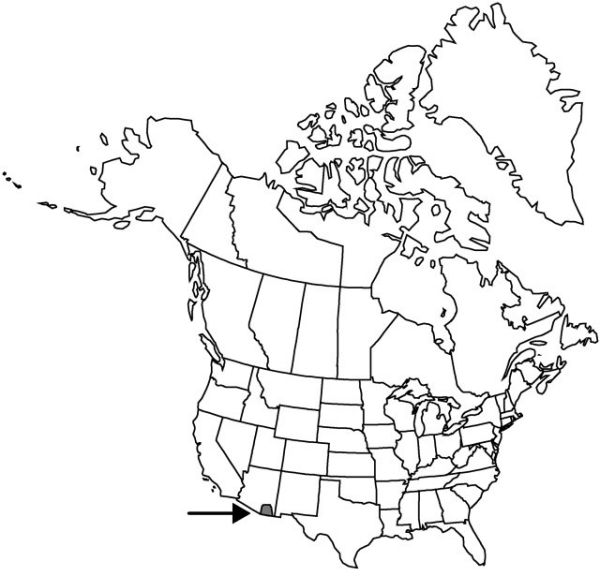Difference between revisions of "Yucca madrensis"
Agave Fam. Sonora, 159, fig. 62. 1972.
FNA>Volume Importer |
FNA>Volume Importer |
||
| Line 24: | Line 24: | ||
|elevation=1400–1600 m | |elevation=1400–1600 m | ||
|distribution=Ariz.;Mexico (Chihuahua;Sonora). | |distribution=Ariz.;Mexico (Chihuahua;Sonora). | ||
| − | |discussion=<p>Yucca madrensis is closely related to Y. jaliscensis to the south and the Y. schottii complex to the north. We follow L. W. Lenz and M. A. Hanson (2000b), who have determined that plants with long, wide, flexible, blue leaves that are now usually identified as Y. schottii Engelmann (not congruent with Engelmann’s original description) are more correctly referred to Y. madrensis. Lenz and Hanson further suggested that what is now called Y. schottii represents a hybrid complex among Y. baccata, Y. elata, and Y. madrensis. This putative hybridization is conjectural, and without firm evidence we are uncertain as to the appropriate disposition of the name Y. schottii. We are somewhat skeptical of the potential for crosses between baccate species (Y. baccata and Y. madrensis) and capsular species (Y. elata).</p> | + | |discussion=<p><i>Yucca madrensis</i> is closely related to Y. jaliscensis to the south and the Y. schottii complex to the north. We follow L. W. Lenz and M. A. Hanson (2000b), who have determined that plants with long, wide, flexible, blue leaves that are now usually identified as Y. schottii Engelmann (not congruent with Engelmann’s original description) are more correctly referred to <i>Y. madrensis</i>. Lenz and Hanson further suggested that what is now called Y. schottii represents a hybrid complex among <i>Y. baccata</i>, <i>Y. elata</i>, and <i>Y. madrensis</i>. This putative hybridization is conjectural, and without firm evidence we are uncertain as to the appropriate disposition of the name Y. schottii. We are somewhat skeptical of the potential for crosses between baccate species (<i>Y. baccata</i> and <i>Y. madrensis</i>) and capsular species (<i>Y. elata</i>).</p> |
|tables= | |tables= | ||
|references={{Treatment/Reference | |references={{Treatment/Reference | ||
| Line 51: | Line 51: | ||
|publication year=1972 | |publication year=1972 | ||
|special status= | |special status= | ||
| − | |source xml=https://jpend@bitbucket.org/aafc-mbb/fna-data-curation.git/src/ | + | |source xml=https://jpend@bitbucket.org/aafc-mbb/fna-data-curation.git/src/8f726806613d60c220dc4493de13607dd3150896/coarse_grained_fna_xml/V26/V26_876.xml |
|genus=Yucca | |genus=Yucca | ||
|species=Yucca madrensis | |species=Yucca madrensis | ||
Revision as of 16:47, 18 September 2019
Plants solitary, caulescent, shorter than 3 m. Stems 1, simple, unbranched, shorter than 2 m. Leaf blade erect to reflexing with age, bluish-glaucous or green to yellow-green, thin, flat to conduplicate, flexible, margins entire or occasionally filiferous with slender fibers, brown to grayish, smooth. Inflorescences erect, paniculate, somewhat open, arising 1/4–1/2 within rosettes, elongate-ovoid, to 8 dm, sparsely pubescent. Flowers pendent, 3.5 cm; perianth ovoid; tepals distinct, or barely connate basally, white, ovate-lanceolate to lanceolate, ca. 3 × 1.4 cm; filaments ca. 1.5 cm, glabrous; pistil 1.5–4 cm; ovary ca. 2.5 cm. Fruits becoming pendent, baccate, indehiscent, 6–12.5 × 2.5–3.8 cm, fleshy, succulent. Seeds gray, 7–10 mm diam., 5–8 mm thick.
Phenology: Flowering in summer with rains.
Habitat: Madrean pine-oak forest
Elevation: 1400–1600 m
Distribution

Ariz., Mexico (Chihuahua, Sonora).
Discussion
Yucca madrensis is closely related to Y. jaliscensis to the south and the Y. schottii complex to the north. We follow L. W. Lenz and M. A. Hanson (2000b), who have determined that plants with long, wide, flexible, blue leaves that are now usually identified as Y. schottii Engelmann (not congruent with Engelmann’s original description) are more correctly referred to Y. madrensis. Lenz and Hanson further suggested that what is now called Y. schottii represents a hybrid complex among Y. baccata, Y. elata, and Y. madrensis. This putative hybridization is conjectural, and without firm evidence we are uncertain as to the appropriate disposition of the name Y. schottii. We are somewhat skeptical of the potential for crosses between baccate species (Y. baccata and Y. madrensis) and capsular species (Y. elata).